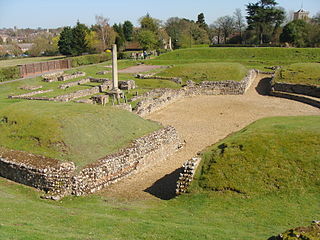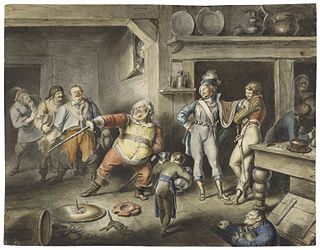Structure and genre
Along with Thomas Preston's Cambises (c.1561), the play has been identified as a "hybrid morality", due to its articulation of classical themes, stories and characters with the medieval allegorical tradition. [7] Within this genre, the central allegorical figure of the Vice vies with a non-allegorical, classical protagonist (Horestes); though their roles are about the same size, Horestes controls the important action. [8]
The play has an episodic structure, which alternates comic, slapstick scenes with serious, tragic ones, all unified by the theme of revenge. [9] It is one of the earliest examples of an English revenge play, a genre that includes Kyd's The Spanish Tragedy (1587), Marston's The Malcontent (1603) and Shakespeare's Hamlet (1601). [10] Unlike traditional moralities, Horestes presents an ambiguous ending. [11] In line with both the Orestia and the Historyes of Troy, Horestes is forgiven for the murder of his mother and her lover; despite its interrogation during the course of the play, however, the justification for the murders remains an unresolved issue at its conclusion. [11] In a further departure from the conventions of the morality, the forgiveness of Horestes is not prompted by his repentance. [11]

English Renaissance theatre, also known as Renaissance English theatre and Elizabethan theatre, refers to the theatre of England between 1558 and 1642.

The masque was a form of festive courtly entertainment that flourished in 16th- and early 17th-century Europe, though it was developed earlier in Italy, in forms including the intermedio. A masque involved music, dancing, singing and acting, within an elaborate stage design, in which the architectural framing and costumes might be designed by a renowned architect, to present a deferential allegory flattering to the patron. Professional actors and musicians were hired for the speaking and singing parts. Masquers who did not speak or sing were often courtiers: the English queen Anne of Denmark frequently danced with her ladies in masques between 1603 and 1611, and Henry VIII and Charles I of England performed in the masques at their courts. In the tradition of masque, Louis XIV of France danced in ballets at Versailles with music by Jean-Baptiste Lully.

The Oresteia is a trilogy of Greek tragedies written by Aeschylus in the 5th century BCE, concerning the murder of Agamemnon by Clytemnestra, the murder of Clytemnestra by Orestes, the trial of Orestes, the end of the curse on the House of Atreus and the pacification of the Furies.

Drama was introduced to Britain from Europe by the Romans, and auditoriums were constructed across the country for this purpose.
Orestes was the son of Agamemnon and Clytemnestra, in Greek mythology.

The English Renaissance was a cultural and artistic movement in England during the late 15th, 16th and early 17th centuries. It is associated with the pan-European Renaissance that is usually regarded as beginning in Italy in the late 14th century. As in most of the rest of Northern Europe, England saw little of these developments until more than a century later within the Northern Renaissance. Renaissance style and ideas were slow to penetrate England, and the Elizabethan era in the second half of the 16th century is usually regarded as the height of the English Renaissance. Many scholars see its beginnings in the early 16th century during the reign of Henry VIII. Others argue the Renaissance was already present in England in the late 15th century.
Revenge tragedy is a theoretical genre, in which the principal theme is revenge and revenge's fatal consequences. Formally established by American educator Ashley H. Thorndike in his 1902 article "The Relations of Hamlet to Contemporary Revenge Plays," a revenge tragedy documents the progress of the protagonist's revenge plot and often leads to the demise of both the murderers and the avenger himself.
A prologue or prolog is an opening to a story that establishes the context and gives background details, often some earlier story that ties into the main one, and other miscellaneous information. The Ancient Greek word πρόλογος includes the modern meaning of prologue, but was of wider significance, more like the meaning of preface. The importance, therefore, of the prologue in Greek drama was very great; it sometimes almost took the place of a romance, to which, or to an episode in which, the play itself succeeded.

David Martin Bevington was an American literary scholar. He was the Phyllis Fay Horton Distinguished Service Professor Emeritus in the Humanities and in English Language & Literature, Comparative Literature, and the college at the University of Chicago, where he taught since 1967, as well as chair of Theatre and Performance Studies. "One of the most learned and devoted of Shakespeareans," so called by Harold Bloom, he specialized in British drama of the Renaissance, and edited and introduced the complete works of William Shakespeare in both the 29-volume, Bantam Classics paperback editions and the single-volume Longman edition. After accomplishing this feat, Bevington was often cited as the only living scholar to have personally edited Shakespeare's complete corpus.

Recuyell of the Historyes of Troye or Recueil des Histoires de Troye (1464) is a translation by William Caxton of a French courtly romance written by Raoul Lefèvre, chaplain to Philip III, Duke of Burgundy. It was the first book printed in the English language.

Elizabethan literature refers to bodies of work produced during the reign of Queen Elizabeth I (1558–1603), and is one of the most splendid ages of English literature. In addition to drama and the theatre, it saw a flowering of poetry, with new forms like the sonnet, the Spenserian stanza, and dramatic blank verse, as well as prose, including historical chronicles, pamphlets, and the first English novels. Major writers include William Shakespeare, Edmund Spenser, Christopher Marlowe, Richard Hooker, Ben Jonson, Philip Sidney and Thomas Kyd.

The Castle of Perseverance is a c. 15th-century morality play and the earliest known full-length vernacular play in existence. Along with Mankind and Wisdom, The Castle of Perseverance is preserved in the Macro Manuscript that is now housed in the Folger Shakespeare Library in Washington, D.C. The Castle of Perseverance contains nearly all of the themes found in other morality plays, but it is especially important because a stage drawing is included, which may suggest theatre in the round.

When You See Me You Know Me is an early Jacobean history play about Henry VIII, written by Samuel Rowley and first published in 1605.
Thomas Preston (1537–1598) was an English master of Trinity Hall, Cambridge, and possibly a dramatist.
Sinnekins are stock characters often found in medieval drama, especially morality plays. They most often occur as pairs of devilish characters who exert their perfidious influence on the main character of the drama.

Drama is the specific mode of fiction represented in performance: a play, opera, mime, ballet, etc., performed in a theatre, or on radio or television. Considered as a genre of poetry in general, the dramatic mode has been contrasted with the epic and the lyrical modes ever since Aristotle's Poetics —the earliest work of dramatic theory.
The Play of the Weather is an English interlude or morality play from the early Tudor period. The play was written by John Heywood, a courtier, musician and playwright during the reigns of Henry VIII, Edward VI and Mary I and published by his brother-in-law, William Rastell, in 1533 as The Play of the Wether, a new and mery interlude of all maner of Wethers. It represents the Roman deity Jupiter on earth asking mortals to make cases for their preferred weather following heavenly dissension among the gods. It is the first published play to nominate "The Vice" on its title page.

History is one of the three main genres in Western theatre alongside tragedy and comedy, although it originated, in its modern form, thousands of years later than the other primary genres. For this reason, it is often treated as a subset of tragedy. A play in this genre is known as a history play and is based on a historical narrative, often set in the medieval or early modern past. History emerged as a distinct genre from tragedy in Renaissance England. The best known examples of the genre are the history plays written by William Shakespeare, whose plays still serve to define the genre. History plays also appear elsewhere in British and Western literature, such as Thomas Heywood's Edward IV, Schiller's Mary Stuart or the Dutch play Gijsbrecht van Aemstel.

Wisdom is one of the earliest surviving medieval morality plays. Together with Mankind and The Castle of Perseverance, it forms a collection of early English moralities called "The Macro Plays". Wisdom enacts the struggle between good and evil; as an allegory, it depicts Christ and Lucifer battling over the Soul of Man, with Christ and goodness ultimately victorious. Dating between 1460 and 1463, the play is preserved in its complete form in the Macro Manuscript, currently a part of the collection of the Folger Shakespeare Library. A manuscript fragment of the first 754 lines also belongs to the Bodleian Library. Although the author of Wisdom remains anonymous, the manuscript was transcribed and signed by a monk named Thomas Hyngman. Some scholars have suggested that Hyngman also authored the play.

The Macro Manuscript is a collection of three 15th-century English morality plays, known as the "Macro plays" or "Macro moralities": Mankind, The Castle of Perseverance, and Wisdom. So named for its 18th-century owner Reverend Cox Macro (1683–1767), the manuscript contains the earliest complete examples of English morality plays. A stage plan attached to The Castle of Perseverance is also the earliest known staging diagram in England. The manuscript is the only source for The Castle of Perseverance and Mankind and the only complete source for Wisdom. The Macro Manuscript is a part of the collection at the Folger Shakespeare Library in Washington, D.C.. For centuries, scholars have studied the Macro Manuscript for insights into medieval drama. As Clifford Davidson writes in Visualizing the Moral Life, "in spite of the fact that the plays in the manuscript are neither written by a single scribe nor even attributed to a single date, they collectively provide our most important source for understanding the fifteenth century English morality play."














